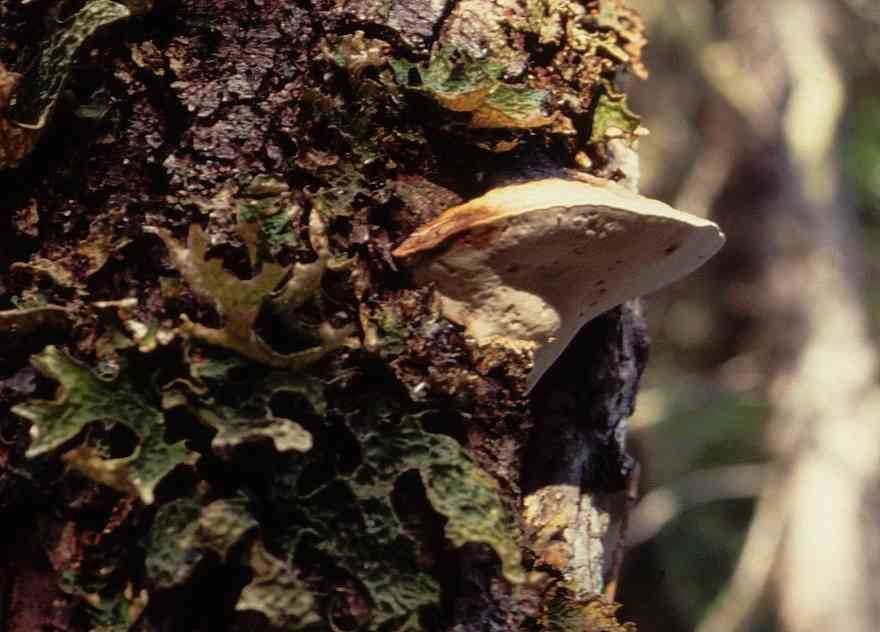Haploporous odoratus
The one and only.
A rare and reclusive fungus. She’s an old woman who lives deep in the woods, keeping the company of plants and animals. She can only be found among old growth diamond willow stands. To add to her rarity, the conditions needed for her to grow at all are highly specific. Diamond willow is not a separate species of willow, the diamond shapes are the result of a fungal infection. There are four or five species of willow that grow the diamond cankers in response to the fungus, primarily thought to be Valsa sordida.
The trees are her closest friends, found together or not at all. Though not bonded in mycorrhizal relationship, they're inseparable because she grows nestled in the diamonds within their flesh. Though she causes white rot in the trees, they protect her fiercely, allowing her to grow nestled into the diamonds, safe from foraging animals and searching eyes.
Sought after for furniture, walking sticks and folk art, the diamond willow grows multiple trunks from a submerged crown. Like a hydra emerging from the surface of the water, they twine their way towards the sunlight that filters through the canopy of taller trees. They grow slowly, achingly. Their branching fans broadly, but rarely does their height reach past twenty feet. These growing pains produce a tensile wood with diamond shapes etched deep into the grain. These are carved out and varnished until they shine. Unaltered by humans, they may become something greater still, a nest for the revered diamond willow fungus.
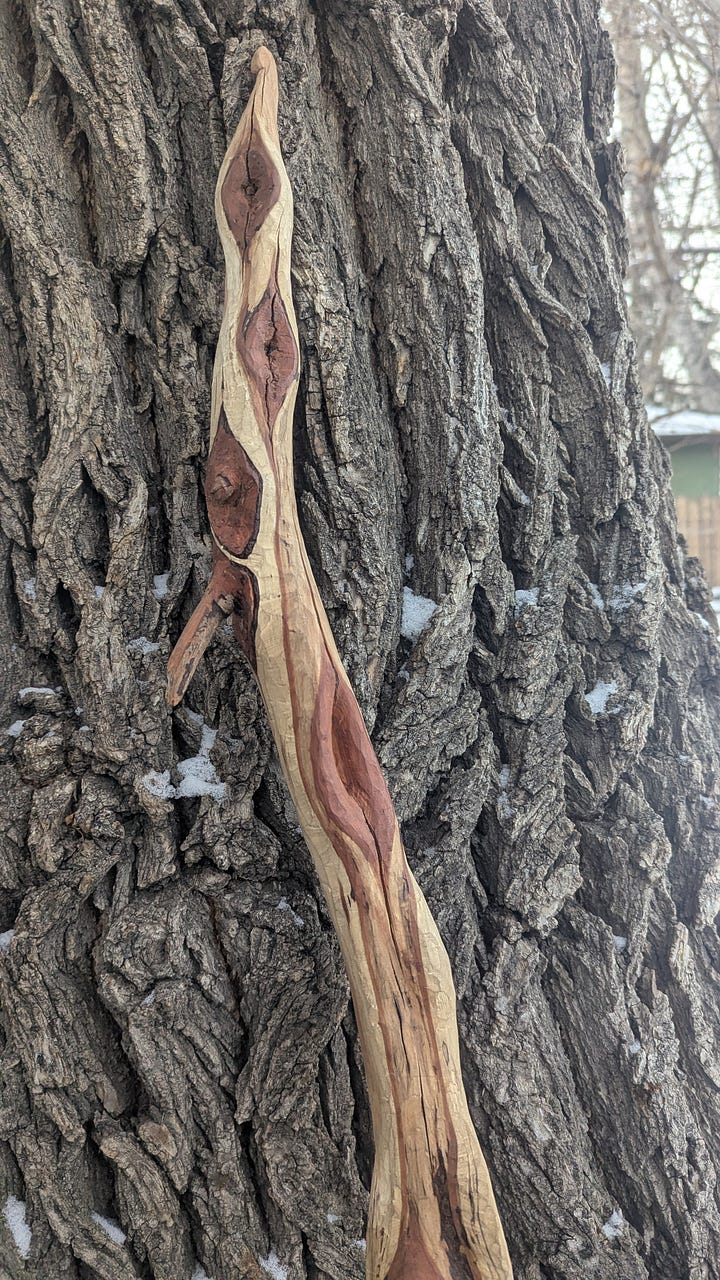
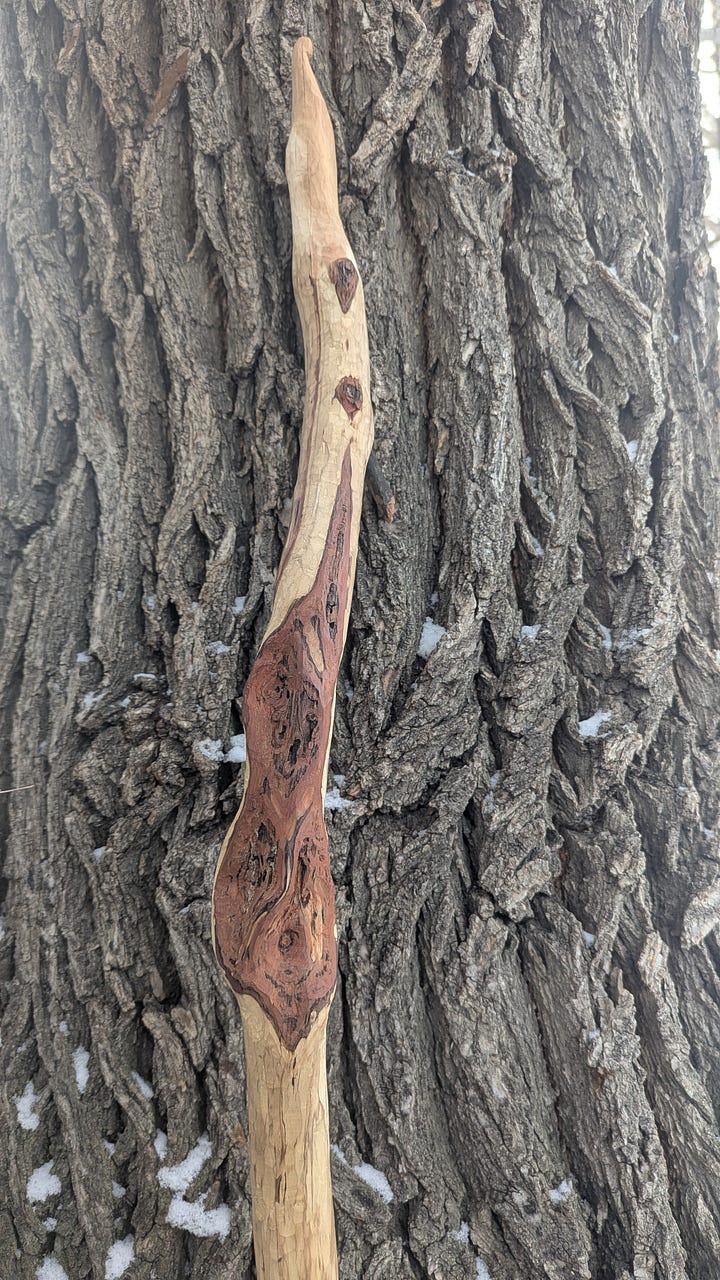
Because her fruiting bodies are frequently found on rotting trunks, many an amateur mycologist has assumed that she is parasitic. But studies have found that her metabolism is saprotrophic, meaning she breaks lignin down into cellulose, hard wood into pulpy fibres, leaving the forest a little softer than she found it.
Many elements need to be present for her to emerge:
First, there needs to be a stand of old growth willow. Second, the willows need to be infected by Valsa sordida - an infection commonly known by urban arborists. It spreads readily and causes die back of branches. The branch falls off, leaving an open wound in the tree for other fungi and viruses to get in. Third, there needs to be a mature diamond willow fungus near enough to spread spores to new trees. This multi-layered ecological interaction explains the fungus' rarity. Illustrated is a deep inter-relatedness that we scarcely understand.
I've read scholarly articles that conflict with one another in the assessment of her life cycle. There is confusion as to cause and effect. Does the tree die because she grows on it, or does she grow there because the tree is dying? Many are investigating, but it's hard to study such a reclusive individual.
I think of her appearance as the final step in untangling the willow's sprawl through the undergrowth of the forest. The necessary decomposition of less available nutrients in wood to create new soil for future generations.
Others have imagined, because she is such a potent medicine, that she acts more like a bandage or a shield over the wound caused by the other fungus.
I invite you, dear reader, to draw your own conclusions at the end of the article. That’s the beauty of studying the fungal kingdom. You can let your imagination run wild theorizing the intentions and functions of every fungi you encounter.
The reality with fungi is: we don’t know much for certain. What we don’t know outweighs what we do. Mycology is an exciting frontier of discovery that can help us understand the intricate web of the world and our place in it.
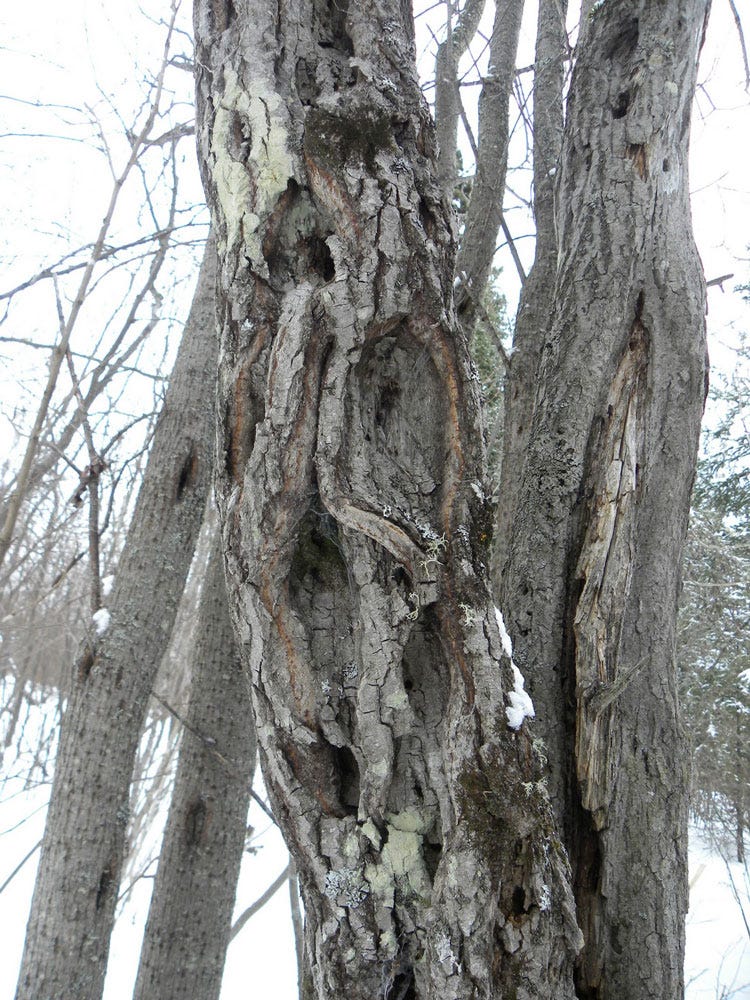
A Rare Gift
There are many polypores (polyporaceae), that grow on the backs of trees, but none so rare as this one. She can only be found north of latitude 51, and various studies have shown that less than 1% of diamond willow stands actually house the fungus. Even then, they are often too small to harvest for many years. The growth of both tree and fungus is slow. When cut open, the fungus displays rings of growth like the inside of a tree.
We can't be sure how widespread she was, even before the current paradigm, marked by mass habitat destruction, species decline and commercial harvesting.
She’s entered our archaeological record through being carved into beads and strung on necklaces, used to adorn robes, blankets and other items. Exact distribution remains obscure as the fungus used in this manner was often mistakenly identified as puffballs (which, if you remember from their chapter, would not retain their creamy whiteness, but would turn a papery brown and puff spores all over the wearer), or as carved cottonwood roots.
Her habitat grows more rare and one must venture deeper into the heart of the forest to find it.
This strikes me as symbolic of the way we treat our elders, shoving them into the folds of the health care system, or into a long term care facility. We no longer seek their wisdom, convinced we've found a better way. Perhaps in ways we have. Each generation improves upon the design of the last, after all. But there's something missing. In building a chain, you do not break all the links that came before. You'd only ever have one link, going nowhere, and weak, not even able to pull a car from a snowbank.
How I met her
A woman visiting from a nearby reserve came to the Swan River Treaty Days pow-wow, bringing with her a leather bag stuffed with foraged herbs. She was a doctor in the medical sense, a general practitioner from further north in Alberta than I'd ever been.
She was also a woman of medicine in the traditional sense. When she chose the healing path, she received a bundle from her aunt containing all the plants that her family had relationships with. The bundle's specific intent was to ward off illness and imbalance. In later years when my path crossed with hers again, she told me she was more often called on to use the contents of the bundle, than the tools of modern medicine. But she has always found they work well together, if balance is maintained.
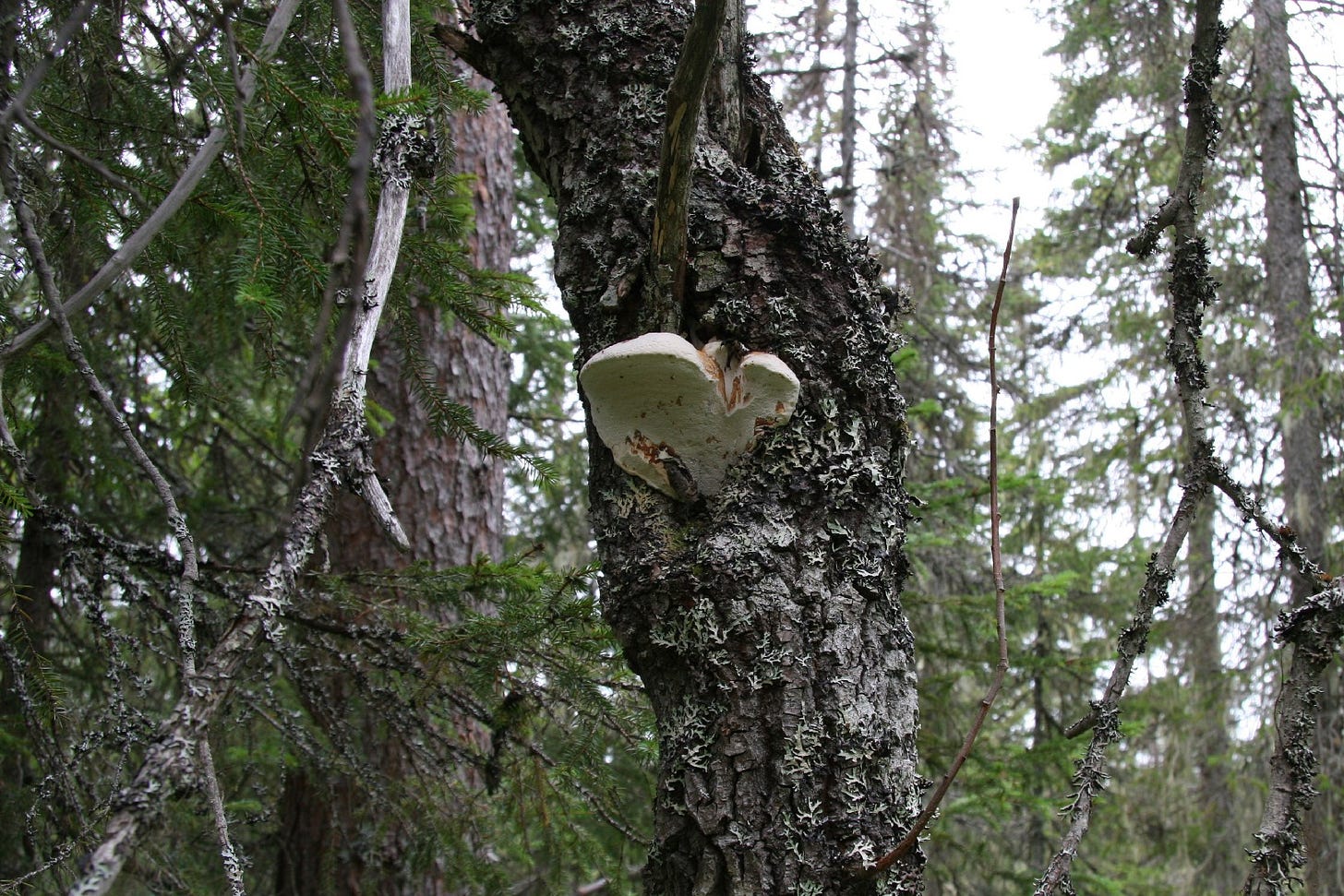
She showed me the bundle's contents at the pow-wow. I was young and distracted, enamored of the flashing colors of the dancer's costumes over her shoulder, so I only recall goldenrod - which she told me was for burns, and diamond willow fungus - because she used it for me.
A friend brought her to my side because the thrumming drums had given me a migraine. My vision darkening with fog, I wanted to run from all the sound and swirling color, the cloying smell of fried bannock and the shouts of kids playing nearby, but the slightest move made me nauseous.
She kneeled down and looked in my eyes. What she saw there brought a laugh to her pursed lips.
“Poor sparrow looks like she flew into a window,” she said. Then she reached into the pouch at her side. A scent wafted from within that reminded me of my mom's baking on a winter afternoon. My nausea subsided, or I was temporarily distracted from it.
All my senses honed in on that smell:
The vanilla extract I spooned into cookies under my mom's strict guidance. “Baking is chemistry, it has to be exact.” My mom smiled as she showed me how to fill the spoon right to the brim without spilling.
The woman introduced herself to me as Cherie, but an elder had given her the name Dancing Willow Woman. “That's why,” she said, “I was given this gift”. Treasured gem of the willows.
Next, she introduced the mushroom by name. She called it Wikmasigan.
She held a lighter under the pale moon shape until it crackled to life with sun-fire. It churned out aromatic smoke. She hummed a rhythm, her jaw taut with tension. As the flame subsided, she fell silent. Her eyes met mine, glittering like embers. She blew the thick smoke into my face and said “breathe deep.” So I did, deeper and deeper until my lungs swelled to bursting.
“Out,” she said. And I coughed an exhale that shuddered my ribcage.
Instead of migraine black, the world blasted into white. Whiter than the first snow fall when the river's wet breath paints spears of hoarfrost on every tree and the sky is white and the ground is white and there is a dizziness in looking into all that whiteness.
My mouth tasted like burnt cookies.
And then, the swirling colors came back into focus. The lady’s fancy dance was making its procession around the circle and the jingle dresses, handmade for the dancers by aunties, kokums, sisters, themselves, made a sweet high ringing sound that no longer cleaved pain into my skull. The colors of the dresses ceased their swirling and I found I could stand without swaying.
“How do you feel?” Eve asked. I could tell she'd been anxious for me to be okay, so we could go watch her mom dance.
“Better.” My words tasted like smoke, a small puff escaped.
“There you go,” Dancing Willow Woman patted my frazzled hair, “little swallow can fly again. Broke right through the window, didn't chaa?”
I nodded, dazed. She handed me a can of cream soda and said “Drink something, kiddo.”
I thanked her the only way I knew how, by giving her a pretty rock from the collection in my pocket.
Eve pulled me up from the bleachers and down to the front of the crowd where we hollered encouragement at her mom.
Her mom, Mae, statuesque in royal blue, looked taller than I remembered. She smiled and her smile took the shape of the magic fungus, burning with the joy of movement.
Revisited
A few years later, Wikmasigan came back into my life.
Yvonne, a Metis woman who taught beading and handicrafts at my school gifted me a tiny piece when I was struck by another migraine that needled my eyes the way I needled the tiny plastic beads arrayed before me.
Like before, the instant the smell entered my nostrils, I felt my senses meld together. She instructed me to inhale from the rising stream of smoke. My mind was transported back to the pow-wow, the smell of kicked-up dirt, hot bannock, and the fungus.
1, 2, 3, I exhaled and when I opened my eyes I thought the beads were fancy dancers forever swirling in my memory. I breathed slow and deep and felt the pounding fade to a light knocking. The beads stopped performing their kaleidoscopic dance and my vision cleared.
Every migraine I've had, and they count too many for my liking, I've thought of that magic fungus and wondered where I could find some. I saw it for sale once, in a booth at North Country Fair, and my hand moved towards it. But seeing her there, inert, wrapped in plastic with a white price label across her face, made me recoil. It didn't feel right. I vowed to only accept her medicine if it was given to me.
Yvonne told me how to find the elusive fungus, and that if I truly needed it, it would be given to me by the forest.
Out of respect for her, because she is no longer on this earth for me to ask permission, I won't share her directions, but my own.
How to meet the Elusive one
For this endeavor, you'll have to be willing to go on a midwinter adventure. Look for the cluttered sprawl of willow. Venture into the moist valleys of coniferous forests, and walk along the thickly tangled banks of rivers blessedly devoid of “now selling waterfront property” signs.
The scent of water is a clue. The musk of a muddy slough will guide you. Willows love water. Walk through the stand of willows, lingering long enough that the breeze caused by your passing can settle around your shoulders like a cloak.
Like sweetgrass, with a similar warm aromatic presence, you'll smell her before you see her, if you see her at all. She'll beckon to you with a hint of vanilla on the wind, which may mean she wants to be found.
The smell grows especially potent with changes of temperature. It’s best to strike towards your stand of diamond willow with the coming of a chinook, or of the prairie's equally elusive spring.
If your nose is so awoken, bask in the aroma for as long as you'd like. Turn slowly in place. Let yourself melt, as into a warm bath. Soften your eyes and awaken your peripheral vision.
Walk around the willows in a circle, she could be hiding anywhere. Scan dead or dying branches for a cream colored half moon shape. Ruddy brown colorations define her edges. A textured greyish cap helps her blend in with the bark from which she emerges.
The bark of diamond willow is a gentle grey. Often it will be mottled with lichens in shades of pumpkin orange and sage green, slate grey and pale yellow. Occasionally, should the air quality be favorable to their growth, you'll find their branches draped in blackened tresses of witches hair, or pale green old man's beard.
One color not frequently expressed among willow branches, however, is the sweet cream of their favorite fungus. Dollops of snow may draw your eye. But snow exudes that crystalline blue glow of the sky world it falls from. She is of the earth, of milk from a cow's udder, ivory from an elephant tusk, the shell of eggs birthed from a chicken.
You spy the color of which I speak, take tentative steps towards it, press your nose hopefully against the fungal flesh, but it smells of snow and tree bark. Begin again.
Trust your senses.
There, a lumped shape pressed into a dimple in the trunk ahead. You move towards it and the smell surrounds you. This time, your nose pressed against it is filled with the scent of your mother's baking, of warm grasses in summer. You've found her.
You press your hand to her skin, it feels soft, like calf skin. Her shallow pores hold mysteries deeper than you'll ever fathom. Her crescent shape fills your palm perfectly. You are reminded of the curve of a horse's hoof.
Ask yourself if you have need of her offerings. Do you or someone you love suffer from headaches, anxiety or wellness problems arising from a shattered psyche? Are you attending a ceremony soon and wish to have a gift to offer the elder?
If so, ask her how she feels about being torn from her womb among the trees. With your olfactory bulb firing and your limbic system in full emotional response. In this place it will be easy to hear her answer. A yes might feel like a warm flood of memory, the caress of love or joy. A no might feel cold: gooseflesh and a tightening of skin, a frightening memory.
If no, spend as much time in her home as you like, then turn towards your own.
If yes, offer her a gift of your own. This could be a herb you've grown in your garden, special to you. A stone you carry. A lock of your hair to be found by the birds in spring and woven into the nest where they'll nurture their young. Then, you will need to slide a knife between her and the tree bark. This will feel sharp and harsh against her softness, but pain is necessary for healing. Don’t cut so deep as to leave the tree open to invasion.
A prying motion should dislodge her into your waiting hand. Pocket your knife and place the other hand against the wound left by her parting. Thank the tree for its part in cultivating your medicine.
You got what you came for. Explore the forest a little more. Get to know her world, as she is about to know yours. When you feel thoroughly introduced, turn your senses toward home.
Many tree mushrooms will need to be sliced while fresh and soft, before they harden to wood and need a saw rather than a kitchen knife. But her medicine is best gifted holistically, her fruiting body intact. So place her somewhere sacred in your home, the hearth or kitchen, wherever you'd imagine a wise old woman would most like to be as she dries to prepare for her new life-revitalizing role. It shouldn't take more than a week for her to be dry enough to hold an ember.
Appreciate the gift, it is not given to just anyone.

In the Wild
Modern medicine couldn't touch my migraines. I suffered through years of misleading diagnoses and prescriptions of increasingly strong painkillers, only to find that the medicine was there all along, waiting in the wild for me, in the knowledge cache of the past.
A well rounded healer, this fungus cures multiple ailments. In addition to migraines, she tends to earaches, sore throats and sinus infections. Instead of burning, soak a piece in water. Then apply the water to the affected area.
Many use her as a smudge to clear the air. You must experience for yourself how the smoke from this potent fungus dispels negative energies left lingering from injury, trauma, anxiety, depression and other harrowing emotional experiences. A pouch of it can be placed under the pillow of one suffering from despair.
If you’re in need of this medicine and unable to venture out to get it, an excellent ethical source of wildcrafted diamond willow fungus is the Peace Valley Foragers: https://www.peacevalleyforagers.ca





